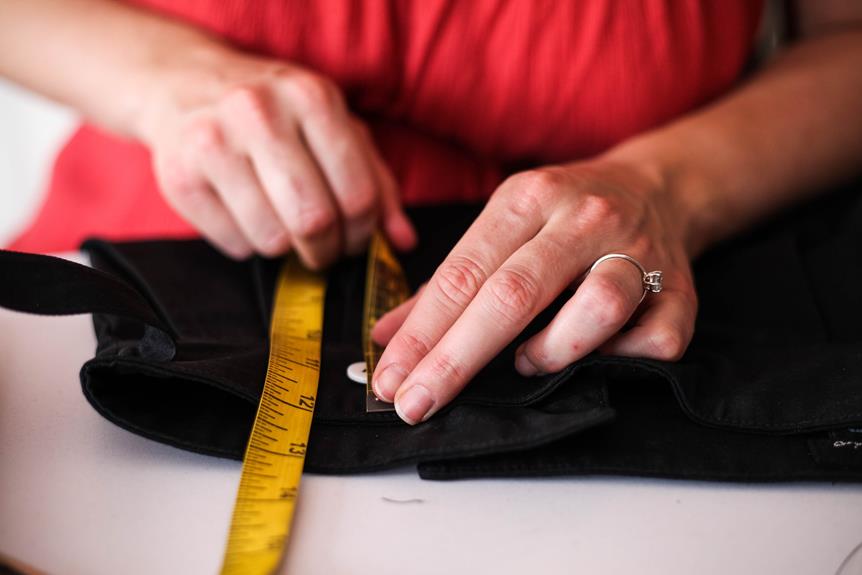Tired of wardrobe malfunctions ruining your day? You're not alone. You've probably heard about dress tape as a solution, but does it really work? In this investigation, we'll dive deep into the world of fabric and fashion to uncover the truth.
As a fabric expert, you're about to discover the science behind dress tape, the different types available, and the pros and cons of using it. Get ready to master the art of applying dress tape and find out if it holds up in real-life testing.
Plus, we'll share expert tips to help you make the most of this fashion lifesaver. It's time to uncover the reality behind dress tape and take control of your style with confidence.
Key Takeaways
- Dress tape uses adhesive technology to create a strong bond with fabrics.
- Different fabrics may require different adhesive strengths.
- Double-sided tape is ideal for securing necklines and hems.
- Proper application techniques and consideration of environmental factors are crucial for ensuring the effectiveness of dress tape.
The Science Behind Dress Tape
You'll want to understand the adhesive properties of dress tape before using it for securing clothing in place. Fabric adhesives play a crucial role in the effectiveness of dress tape. The adhesive technology used in dress tape is designed to create a strong bond with various fabrics, ensuring that it holds garments in place without causing damage. Understanding how the adhesive works with different fabrics can help you choose the right dress tape for your specific clothing needs.
Fabric adhesives used in dress tape are formulated to provide a secure hold while still being gentle on the fabric. This requires a delicate balance of adhesive strength and fabric compatibility. Adhesive technology has advanced significantly, allowing dress tape to adhere effectively to a wide range of fabrics, including delicate and stretchy materials. It's important to consider the type of fabric you'll be using the dress tape on to ensure that the adhesive properties are suitable for the garment.
Types of Dress Tape and Their Uses
Let's talk about the different types of dress tape and how they can be used.
Double-sided tape is great for securing necklines and hems, while clear tape is perfect for more discreet applications.
Understanding the uses of each type will help you choose the right tape for your outfit needs.
Double-Sided Vs. Clear Tape
To effectively secure your clothing, it's important to understand the differences between double-sided and clear dress tape and how each type serves specific purposes. Double-sided tape is a strong adhesive tape with adhesive on both sides, ideal for securing fabric to fabric or fabric to skin. On the other hand, clear dress tape is a transparent, single-sided adhesive tape that is perfect for securing clothing in place without being visible. Here's a comparison of the two types of dress tape:
| Double-Sided Tape | Clear Tape |
|---|---|
| Strong adhesive | Transparent |
| Ideal for fabric-to-fabric or fabric-to-skin | Perfect for securing clothing invisibly |
| May leave residue | May not hold heavy fabrics well |
Understanding the differences between these types of dress tape can help you choose the right one for your specific needs and ensure your clothing stays in place flawlessly.
Securing Neckline or Hems
Securing your neckline or hems with the appropriate type of dress tape is crucial for ensuring a polished and secure fit. When choosing dress tape for securing necklines or hems, consider fabric compatibility and application technique.
Opt for fabric-friendly tapes to prevent damage or residue on delicate materials. Clear, double-sided, or specialized fabric tapes are suitable for different garment types. The longevity of the tape's hold is essential, so select a tape that suits the occasion and duration of wear.
Proper removal processes are vital to prevent damage to the fabric, especially for delicate or intricate garments. Mastering the art of securing necklines or hems with dress tape involves understanding the nuances of fabric compatibility, application techniques, longevity of hold, and the gentle removal process.
Pros and Cons of Using Dress Tape
So, you're wondering about the pros and cons of using dress tape. Let's talk about how effective it's on different fabrics, the potential for skin irritation, and its durability in varied conditions.
These points will give you a clear understanding of whether dress tape is the right solution for your outfit needs.
Effectiveness on Different Fabrics
When using dress tape, different fabrics require varying levels of adhesion to ensure a secure hold throughout the day. Silk, known for its delicate and smooth texture, can benefit from dress tape due to its lightweight nature. However, the effectiveness of dress tape on silk may vary depending on the specific weave and thickness of the fabric. It's important to test a small area before applying dress tape to a prominent part of the garment.
On the other hand, satin, with its glossy and lustrous surface, tends to adhere well to dress tape, providing a reliable hold. Nonetheless, the durability of the hold on satin may be affected if the garment experiences frequent movement or friction.
Understanding the nuances of different fabrics is crucial in determining the effectiveness of dress tape for securing garments in place.
Skin Irritation Potential
You may encounter skin irritation when using dress tape, especially if you have sensitive skin or are prone to allergies. The adhesive strength of the tape can sometimes cause skin sensitivity or even mild rashes, particularly when used for extended periods or in hot, humid conditions. It's important to consider your skin type and any previous reactions to adhesives before using dress tape. Here's a comparison of the skin irritation potential based on skin sensitivity and adhesive strength:
| Skin Sensitivity | Low Adhesive Strength | Medium Adhesive Strength | High Adhesive Strength |
|---|---|---|---|
| Low | Minimal irritation | Slight irritation | Moderate irritation |
| Medium | Slight irritation | Moderate irritation | Significant irritation |
| High | Moderate irritation | Significant irritation | Severe irritation |
Understanding the potential for skin irritation based on these factors can help you make an informed decision about using dress tape.
Durability in Varied Conditions
Dress tape's durability in varied conditions presents both advantages and drawbacks for users, impacting its effectiveness in different situations. Durability testing is crucial to assess how well the tape holds up in different environments, such as high humidity, extreme temperatures, or during physical activity.
The pros of using dress tape in varied conditions include its ability to provide reliable support and adherence to fabrics, ensuring that your outfit stays in place throughout the day or night.
However, the environmental impact of dress tape should also be considered, as some tapes may not be biodegradable or eco-friendly.
Additionally, in certain conditions, such as excessive sweating or prolonged wear, the adhesiveness of the tape may weaken, requiring reapplication.
Understanding the limitations and benefits of dress tape's durability in varied conditions is essential for making informed decisions when using it.
How to Properly Apply Dress Tape
To properly apply dress tape, it's important to ensure that the skin is clean and dry before use. Follow these steps for a successful application:
- Preparation: Clean the skin with alcohol to remove any oils or lotions that could prevent the tape from adhering properly.
- Cutting: Use scissors to cut the desired length of tape, and round the edges to prevent them from lifting.
- Application: Gently place the tape on the skin, avoiding any wrinkles or creases. Press down firmly to ensure it sticks securely.
- Troubleshooting: If the tape starts to lift or lose its adhesion, try applying a small amount of heat from a hairdryer to reactivate the adhesive.
By following these steps, you can ensure that the dress tape adheres properly and stays in place throughout the day.
If any issues arise, such as the tape not sticking or causing irritation, consider using a different brand or consulting with a professional for alternative solutions.
Real-life Testing of Dress Tape
After properly applying the dress tape, you can assess its effectiveness by wearing your chosen outfit in various real-life situations. Real-life testing is crucial to determine how well the dress tape holds up during regular activities.
While going about your day, take note of how the dress tape performs. Does it keep your clothing in place as you move around, sit, or dance? Consider user experiences shared by others who've used dress tape in similar situations. Pay attention to factors such as temperature, humidity, and fabric type, as these can affect the tape's performance.
Take note of any discomfort or irritation caused by the tape, as this is an important aspect of real-life testing. Additionally, evaluate the longevity of the tape's adhesive properties throughout the day.
Expert Tips for Using Dress Tape
When using dress tape, ensure proper application by following these expert tips for maximum garment support and confidence.
- Prepare Your Skin: Before applying dress tape, ensure your skin is clean and dry to maximize adhesion and prevent irritation.
- Cut the Tape to Size: Use sharp scissors to cut the dress tape to the desired length, making sure it's sufficient to provide support without being visible.
- Apply with Precision: Gently remove the backing from the tape and apply it to your skin, ensuring it's secure but not too tight. Smooth out any wrinkles or air bubbles for a seamless finish.
- Remove with Care: When it's time to remove the tape, slowly peel it away from your skin, moving in the direction of hair growth to minimize discomfort and potential skin irritation.
Remember, while dress tape can be a helpful tool, there are alternatives such as adhesive bras or fashion tape strips. When using dress tape, always consider dress tape removal techniques to ensure you don't damage your garments or irritate your skin.
Mastering these tips will elevate your confidence and ensure your garments stay in place all day or night.
Frequently Asked Questions
Can Dress Tape Be Used on Delicate Fabrics Like Silk or Lace?
You can use dress tape on delicate fabrics like silk or lace with caution. Take care when applying to silk to avoid damage, and ensure the tape is gentle enough for lace maintenance without causing tears.
Is Dress Tape Waterproof and Suitable for Use in Swimwear or Other Water-Resistant Garments?
Dress tape is not waterproof and may not be suitable for swimwear or water-resistant garments. When applying dress tape to delicate fabrics like silk or lace, use caution to avoid damage. To remove, gently peel off and discard.
Can Dress Tape Be Used to Alter the Fit of a Garment, Such as Taking in a Loose Waistline or Adjusting the Neckline?
Yes, dress tape can be used to alter the fit of a garment, such as taking in a loose waistline or adjusting the neckline. It's particularly effective with stretchy fabrics and can also work with garments featuring lace embellishments.
Does Dress Tape Leave Behind Any Residue or Damage the Fabric When Removed?
When using dress tape, be cautious of potential residue and fabric damage upon removal. Proper application and removal techniques, such as gently peeling and using a residue remover, can help minimize these issues.
Are There Any Potential Allergic Reactions or Skin Sensitivities Associated With Using Dress Tape?
Potential reactions or skin sensitivities may arise when using dress tape. It's important to consider safety considerations and be aware of alternative options if you have sensitive skin. Always test a small area first.





